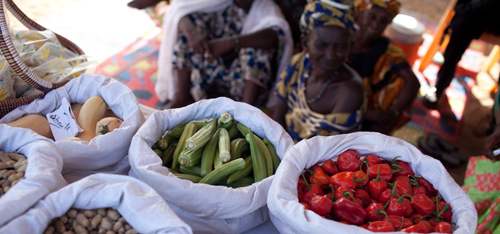Training of facilitators
A fundamental element of the FFS model is the training of current and new field agents from government, NGOs, parastatal and farmer organizations, who become facilitators to conduct the field schools.
The first Training of Facilitators (ToF) in West Africa was held in Ghana in 1996 and was led by master trainers from Indonesia and the Philippines. The training has since spread to around 30 countries in sub-Saharan Africa. In francophone West Africa, training of facilitators started with the implementation of the Integrated Production and Pest Management (IPPM) programme in Burkina Faso, Mali and Senegal in 2001. Participants from West Africa who were trained in Ghana carried out the pilot training in the three countries. The ToF have now expanded to 10 countries implementing the IPPM programme.
Training takes place in season long ToF, based on complementary and tightly associated practice and theory in a non-formal education approach. The learning process is closely associated to the substance and temporal course of the FFS that the facilitators will have to animate.
The diverse operating contexts of West Africa require that the training of facilitators is just as flexible as the FFS themselves. To optimise cost and time, the programme has designed distinct ToF training models, with season-long training being the unifying theme.
Two main ToF models exist:
- Trainees leave their home for extended periods (residential ToF):
- Continued-residential ToF: trainees live and work in a training facility for the whole length of the growing season (3-4 months).
- Sequential-residential ToF: trainees live and work intermittently in a training center; timed to coincide with the critical management periods during the season, and interspersed with periods spent working at home, where they put in practice what they are learning.
- Trainees are not required to leave their place of living (localised ToF):
- Continued-localized ToF: trainees do not leave their place of residence and the training is continuous for the whole length of the growing season;
- Sequential-localized ToF: trainees do not leave their place of residence and the training is intermittent and follows the growing-season.
In West Africa, the programme has placed particular emphasis on training local farmers as facilitators because it proposes the best method of anchoring the programme's approach within the community and at sub-district level. Farmers are generally selected by their communities and are naturally expected to return home with useful skills and knowledge to share. This degree of social expectation lends most farmers who undertake training to be highly motivated; leading to a higher level of success.
The programme asks each community to select two representatives who must be active healthy farmers and able to read and write. A typical ToF includes no more than 30 trainees. To date, approx. 66 percent of the facilitators trained in the seven countries are farmers (more than 3 200 facilitators), of which 17 percent are women.
On completion of the ToF, the newly trained facilitators become part of the training support network and begin animating FFS in their respective communities. Initially these animations are carried out in pairs and often under the supervision of a Master trainer during their first year.

